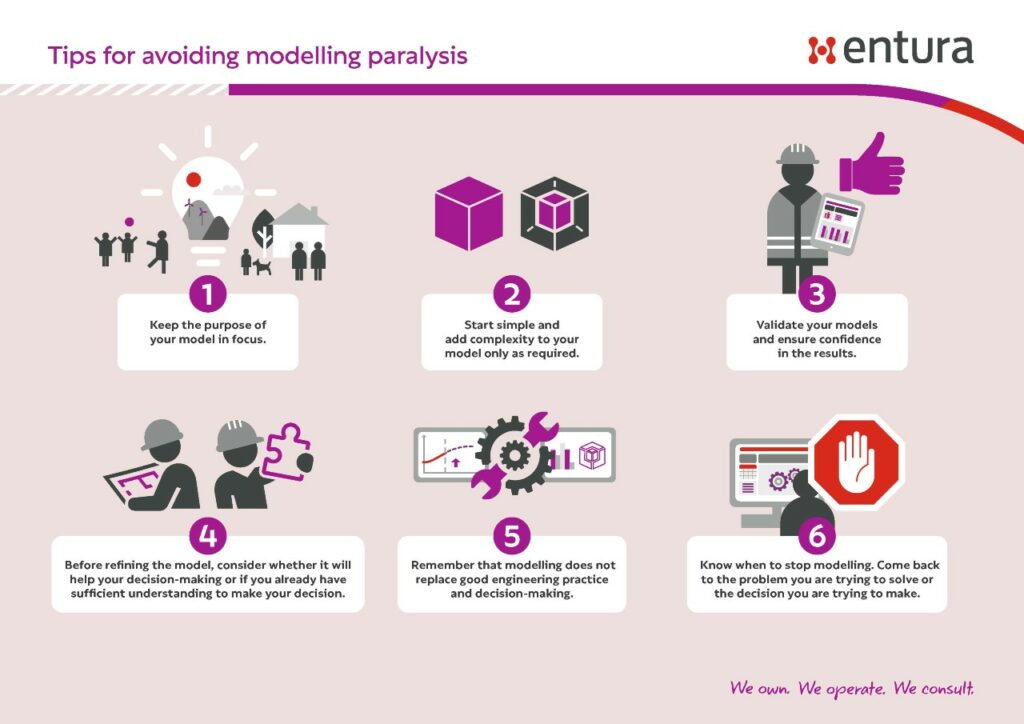THOUGHT LEADERSHIP
How to avoid analysis paralysis

Modelling has a very important role in every sphere of engineering. Complex mathematic models help us better predict and understand behaviours and performance so that we can solve technical problems, push the boundaries of applied science, and optimise construction and manufacturing.
We use finite element models (FEM) to determine the forces, stresses and deflections of a complex structure. We use computational fluid dynamics (CFD) to analyse complex three-dimensional hydraulic problems and determine flow vectors, velocities, water depths and pressure fluctuations. A complex finite difference model (such as FLAC) helps us model complex geotechnical problems. A rainfall–runoff model supports our understanding of potential flooding along a river channel.
In the 30+ years that I have worked in civil engineering, computing power has increased dramatically. As a result, modelling tools have become more powerful, enabling engineers to model increasingly complex principles and problems. For example, we can model non-linear stress–strain properties of materials, rather than simply assuming that they are linear. We can model the turbulent nature of water hydraulics, rather than assuming that the flow is laminar.
The advantage of having more powerful and more extensive modelling tools available to engineers is a significant improvement in our understanding and therefore, in many cases, a corresponding improvement in the engineering. But there is a potential downside: the risk of ‘analysis paralysis’, which is when our ability to make timely decisions is impeded by over-analysing or over-thinking scenarios or alternatives.
I am not a psychologist, but some say the root cause of analysis paralysis is the fear of making the wrong decision, choosing the wrong option or missing out on a potentially superior solution. This fear drives ongoing analysis, and the result is a loss of the expected or potential value of a timely, successful decision. Rather than making a decision, we try to preserve all existing options, continuing to analyse and refine.
This might look like a lower risk strategy, but it is actually a losing strategy. Complex modelling with an overload of scenarios, alternatives, sensitivity analyses or options can overwhelm the situation, making it very difficult to reach conclusions and make the decisions that are inevitably needed to move the project forward. This can potentially cause a bigger issue than if a decision had been made earlier. Prolonging the modelling and analysis phase will merely postpone, not eradicate, the risks associated with implementation. At some point, implementation will be expected.
It is very important to always remember the purpose of modelling, which is to help us understand a problem in order to make decisions – in many cases, engineering decisions. Engineering should drive the process. Although we may be able to refine a model further, perhaps we already have sufficient understanding to make the necessary engineering decisions, so the extra refinement is superfluous. Just because you can refine a model, or add complexity to a model to better reflect reality, doesn’t mean you should. The more refined and complex a model becomes, the more time is required to develop, analyse and interpret the results. It also becomes harder to validate the results, which is critical; blind faith in any complex numerical model is dangerous.
Early in my career, in relation to finite element modelling of dams, a mentor advised me to start simple with the model, validating the results against real data and known engineering behaviours to develop confidence in the model before adding further complexity. A big driver for this process was the extensive run times of these models three decades ago. Despite the progress in modelling over the decades, I believe that there is still a lot of merit in this gradual process of building complexity into a model. However, due to the software and computing power available today, a high degree of complexity is often built into a model right from the start. When this occurs, the modelling can become less of an engineering tool and more like a dark art.
The computing power available today certainly offers engineers access to some amazing inputs for our design processes. But numerical modelling does not replace the engineering. No matter how much modelling we do, we must still eventually make some important engineering decisions. If further refinement of the model won’t change the engineering decision, it’s time to stop. Don’t fall into the trap of analysis paralysis!
In summary, my tips for avoiding modelling paralysis are:
- Keep the purpose of your model in focus.
- Start simple and add complexity to your model only as required.
- Validate your models and ensure confidence in the results.
- Before refining the model, consider whether it will help your decision-making or if you already have sufficient understanding to make your decision.
- Remember that modelling does not replace good engineering practice and decision-making.
- Know when to stop modelling. Come back to the problem you are trying to solve or the decision you are trying to make.

To talk further with an Entura specialist about your modelling challenges, contact Richard Herweynen.
About the author
Richard Herweynen is Entura’s Technical Director, Water. Richard has three decades of experience in dam and hydropower engineering, and has worked throughout the Indo-Pacific region on both dam and hydropower projects, covering all aspects including investigations, feasibility studies, detailed design, construction liaison, operation and maintenance and risk assessment for both new and existing projects. Richard has been part of a number of recent expert review panels for major water projects. He participated in the ANCOLD working group for concrete gravity dams and is the Chairman of the ICOLD technical committee on engineering activities in the planning process for water resources projects. Richard has won many engineering excellence and innovation awards (including Engineers Australia’s Professional Engineer of the Year 2012 – Tasmanian Division), and has published more than 30 technical papers on dam engineering.
MORE THOUGHT LEADERSHIP ARTICLES
31 January, 2023






